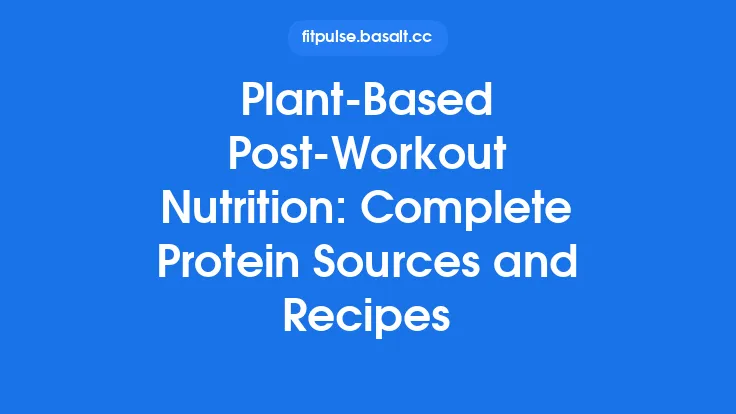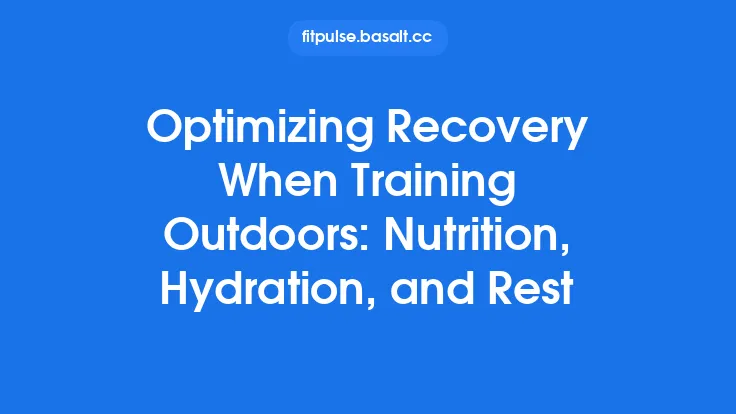When you finish a training session, your muscles are primed for repair, rebuilding, and growth. The stimulus you just applied—whether it was a heavy‑weight squat, a sprint interval, or a long‑distance run—has caused microscopic damage to muscle fibers and depleted the amino acid pool that fuels protein synthesis. Supplying high‑quality protein in the aftermath provides the building blocks (essential amino acids) and the signaling cues needed to turn that damage into stronger, more resilient tissue. Understanding exactly how much protein to consume and when to deliver it can make the difference between modest improvements and maximal adaptation, while also supporting overall recovery, immune function, and body composition goals.
The Science Behind Post‑Workout Protein Synthesis
Muscle Protein Synthesis (MPS) vs. Muscle Protein Breakdown (MPB)
After exercise, two opposing processes occur simultaneously:
| Process | What It Does | Primary Drivers |
|---|---|---|
| Muscle Protein Synthesis (MPS) | Builds new contractile proteins, repairs damaged fibers, and contributes to hypertrophy. | Availability of essential amino acids (especially leucine), insulin, mechanical tension, and hormonal milieu (e.g., growth hormone, testosterone). |
| Muscle Protein Breakdown (MPB) | Degrades existing proteins to provide substrates for energy and repair. | Elevated cortisol, catecholamines, and a negative net protein balance. |
The net effect on muscle remodeling depends on the balance between MPS and MPB. Consuming protein post‑exercise shifts this balance toward net protein accretion by:
- Providing a rapid supply of essential amino acids (EAAs). Leucine, in particular, acts as a molecular switch that activates the mTORC1 pathway, the master regulator of MPS.
- Elevating insulin modestly. While insulin is not a primary driver of MPS, it suppresses MPB and improves amino acid uptake.
- Replenishing the intracellular amino acid pool, which may have been depleted during the workout.
The Role of Leucine and the “Leucine Threshold”
Research consistently shows that a leucine dose of ~2–3 g is required to maximally stimulate mTORC1 and trigger a robust MPS response in most adults. This “leucine threshold” can be reached with:
- ~20–25 g of high‑quality whey protein (≈10 % leucine)
- ~30–35 g of soy or pea protein (≈7–8 % leucine)
- ~40–45 g of lower‑quality plant blends that are lower in leucine density
If the leucine content falls below the threshold, the MPS response is blunted, even if total protein intake is adequate.
How Much Protein Should You Aim for Post‑Workout?
General Recommendations
| Population | Protein Dose (g) | Rationale |
|---|---|---|
| Recreational lifters (≤3 sessions/week) | 20–25 g | Sufficient to reach leucine threshold for most individuals; supports modest hypertrophy and recovery. |
| Trained athletes (≥4 sessions/week) | 25–40 g | Higher muscle mass and training volume increase the absolute amount of amino acids needed to saturate MPS. |
| Endurance athletes | 20–30 g | Emphasis on repairing oxidative damage and supporting glycogen‑linked protein turnover. |
| Older adults (≥65 y) | 30–40 g | Age‑related anabolic resistance requires a larger dose to achieve the same MPS response. |
| Weight‑loss or calorie‑restricted phases | 30–40 g | Preserves lean mass while in a negative energy balance. |
These values are per feeding, not per kilogram of body weight. However, a useful rule of thumb for fine‑tuning is 0.25–0.40 g protein per kilogram of body weight in the post‑exercise window. For a 80 kg athlete, that translates to 20–32 g of protein.
Why “One‑Size‑Fits‑All” Doesn’t Work
- Body composition: Larger individuals with more lean mass have a greater absolute requirement for amino acids.
- Training intensity & volume: High‑intensity interval training (HIIT) or heavy resistance sessions cause more protein turnover than low‑intensity steady‑state cardio.
- Protein quality: Lower‑quality proteins (e.g., some plant sources) may need higher doses to achieve the same leucine intake.
- Metabolic health: Insulin sensitivity influences how efficiently amino acids are taken up by muscle cells.
Timing: When Is the Optimal Window?
The “Anabolic Window” Revisited
Early studies suggested a narrow 30‑minute window post‑exercise during which protein intake was critical. More recent meta‑analyses indicate that the window is broader, extending up to 3–5 hours after training, especially when total daily protein intake meets or exceeds 1.6 g·kg⁻¹·day⁻¹.
Key points:
- Immediate intake (0–30 min) maximizes the rapid rise in plasma amino acids and insulin, which can be advantageous when training sessions are spaced closely (e.g., two sessions in one day).
- Delayed intake (1–3 h) still yields a strong MPS response, provided the protein dose meets the leucine threshold.
- Very delayed intake (>5 h) may see a diminished MPS response, but overall daily protein distribution becomes the dominant factor.
Practical Timing Strategies
| Scenario | Recommended Timing |
|---|---|
| Single daily training session | Consume protein within 2 hours post‑workout. |
| Two training sessions in one day | Provide ~20 g protein within 30 min after the first session, then another ~20 g after the second. |
| Morning workouts with a long gap before lunch | A fast‑acting protein shake (whey or hydrolyzed) immediately after training, followed by a balanced meal later. |
| Evening workouts | A protein‑rich snack (e.g., Greek yogurt, cottage cheese) within 30 min, ensuring it does not interfere with sleep quality. |
Choosing the Right Protein Source
High‑Quality Animal‑Based Proteins
| Source | Protein (g per 100 g) | Leucine (g per 100 g) | Digestibility (PDCAAS) |
|---|---|---|---|
| Whey concentrate | 78 | 8.5 | 1.00 |
| Whey isolate | 90 | 9.5 | 1.00 |
| Casein | 80 | 7.5 | 1.00 |
| Egg white | 11 | 1.2 | 1.00 |
| Lean beef | 22 | 2.0 | 0.92 |
- Whey is rapidly digested, leading to a quick spike in plasma amino acids—ideal for the immediate post‑workout period.
- Casein digests slower, providing a sustained release of amino acids; useful if the next meal is several hours away.
Plant‑Based Proteins
| Source | Protein (g per 100 g) | Leucine (g per 100 g) | PDCAAS |
|---|---|---|---|
| Pea isolate | 80 | 6.5 | 0.89 |
| Soy isolate | 90 | 7.0 | 0.99 |
| Rice protein | 80 | 5.5 | 0.70 |
| Hemp protein | 50 | 3.5 | 0.60 |
- Blending complementary plant proteins (e.g., pea + rice) can raise the overall leucine content and improve the amino acid profile.
- Fortification with isolated leucine or adding a small amount of whey (if not strictly vegan) can help meet the leucine threshold.
Hydrolyzed vs. Intact Proteins
Hydrolyzed proteins are pre‑digested into short peptide chains, leading to faster absorption. They can be advantageous for:
- Athletes with gastrointestinal sensitivity.
- Situations where rapid amino acid delivery is desired (e.g., within 30 min post‑high‑intensity session).
However, the performance difference compared with high‑quality intact whey is modest for most individuals.
Distribution Across the Day: The Bigger Picture
While the post‑workout dose is crucial, evenly distributing protein intake across 3–4 meals maximizes cumulative MPS. A practical schema:
| Meal | Protein (g) | Example |
|---|---|---|
| Breakfast | 0.25 × daily protein | 30 g Greek yogurt + 20 g whey |
| Mid‑morning snack | 0.15 × daily protein | 15 g mixed nuts + 10 g pea protein bar |
| Lunch (pre‑ or post‑workout) | 0.30 × daily protein | 120 g grilled chicken + quinoa |
| Afternoon snack | 0.10 × daily protein | 1 boiled egg + cheese |
| Dinner (post‑workout if evening) | 0.20 × daily protein | 150 g salmon + sweet potato |
This approach ensures that each feeding provides at least 0.25 g kg⁻¹ of protein, keeping the muscle in a repeatedly anabolic state throughout the day.
Special Considerations
1. Older Adults & Anabolic Resistance
- Higher dose: 30–40 g per serving.
- Leucine enrichment: Adding 2–3 g free leucine can overcome blunted signaling.
- Combine with resistance training: Even light resistance exercise restores sensitivity to protein.
2. Female Athletes
- No fundamental difference in protein needs, but hormonal fluctuations (e.g., menstrual cycle) can affect protein turnover.
- During the luteal phase, a modest increase (≈10 %) in protein intake may support slightly higher MPB.
3. Low‑Carbohydrate or Ketogenic Diets
- Protein requirements may rise to 2.0 g·kg⁻¹·day⁻¹ to preserve lean mass.
- Ensure the post‑workout protein is high‑leucine and consider adding a small amount of fast‑acting carbohydrate (e.g., 15 g fruit) if glycogen replenishment is also a goal.
4. Rapid Weight‑Loss Phases
- Prioritize protein timing around training to protect muscle.
- Use protein‑dense, low‑calorie sources (e.g., whey isolate, low‑fat dairy, lean poultry).
5. Allergies & Intolerances
- For dairy‑intolerant individuals, egg white protein, pea isolate, or hydrolyzed soy are viable alternatives.
- Verify that the chosen product is free from cross‑contamination if strict avoidance is required.
Practical Tips for Implementing Your Post‑Workout Protein Plan
- Pre‑package your dose. Measure 20–30 g of your chosen protein powder into a shaker bottle the night before.
- Pair with a small carbohydrate (optional). 15–20 g of fruit or a low‑glycemic carb can modestly raise insulin, further suppressing MPB without compromising a low‑carb approach.
- Mind the temperature. Warm liquids can speed gastric emptying; a cold shake may be more palatable after intense heat training.
- Track leucine intake. Many nutrition apps now list leucine per serving; aim for ≥2 g per post‑workout dose.
- Adjust for training load. On days with multiple heavy sessions, increase the protein dose by 5–10 g per session.
- Stay consistent. The cumulative effect of daily protein distribution outweighs occasional deviations.
Frequently Asked Questions
Q: Is a protein shake necessary, or can whole foods suffice?
A: Whole foods can absolutely meet post‑workout needs, but protein powders offer convenience, precise dosing, and rapid digestion—especially useful when timing is tight.
Q: How does the type of exercise (strength vs. endurance) affect protein needs?
A: Strength training induces greater muscle protein synthesis, often requiring slightly higher protein doses. Endurance exercise also stimulates MPS but places more emphasis on repairing oxidative damage; a moderate dose (20–30 g) is typically sufficient.
Q: Can I exceed the recommended protein dose without harm?
A: Consuming up to 40 g post‑workout is safe for most adults and may be beneficial for large athletes. Excess protein beyond what the body can use for MPS is oxidized for energy or stored as fat, but it does not confer additional anabolic benefit.
Q: Does the timing of my next meal matter after the post‑workout protein?
A: Yes. If the next meal is >3 hours away, consider a slower‑digesting protein (casein) or a second small dose to maintain amino acid availability.
Q: Should I combine protein with BCAAs or EAAs?
A: Whole protein sources already contain the full spectrum of EAAs, including BCAAs. Supplementing with isolated BCAAs offers little extra benefit if you’re already meeting protein targets.
Bottom Line
Optimizing post‑workout protein intake hinges on three pillars:
- Quantity: Aim for 20–40 g of high‑quality protein per serving, adjusting for body size, training status, age, and dietary preferences.
- Leucine Content: Ensure at least 2–3 g of leucine to fully activate the mTORC1 pathway.
- Timing: Consume the protein within a 2‑hour window after training, with a rapid dose (whey or hydrolyzed protein) if you need immediate amino acid delivery, and consider a slower source if the next meal is delayed.
When these elements are integrated into a balanced daily protein distribution, you create a nutritional environment that consistently favors muscle repair, growth, and overall recovery—turning every workout into a stepping stone toward stronger, healthier performance.





